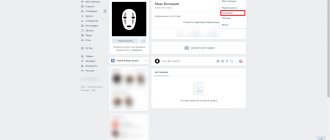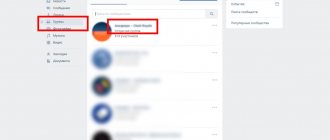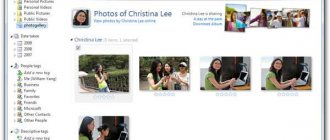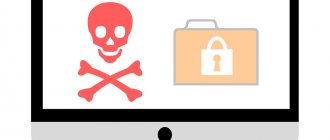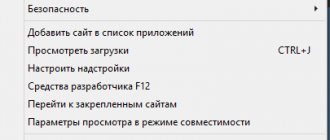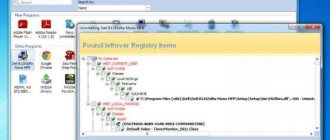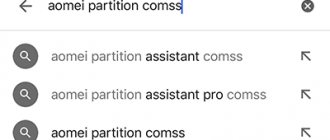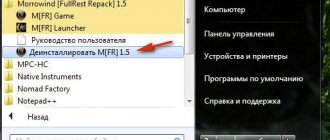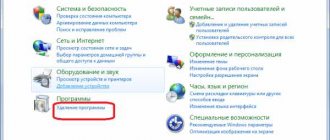» Terms
Anton Nazarenko 02/21/2018
Desktop (from English “desktop”) is the main working environment of our computer, which allows us to use the computer comfortably.
Judge for yourself, without a desktop it would be much more difficult. Desktops are different.
On the Windows operating system it looks something like this:
Rice. 1. Windows OS desktop.
On Linux something like this:
Rice. 2. Linux desktop.
In general, as you already understand, they are different, beautiful and not so beautiful.
We will look at the desktop area using Windows 10 as an example.
Conventionally, the desktop can be divided into two areas: the shortcut area (red line) or the main area and the taskbar (yellow line).
Rice. 3. Desktop example.
Let's look at everything in order. Let's start with the taskbar.
What is the desktop.ini icon?
Desktop.ini is a file containing information about a directory, used in all versions of Windows, including 7 and 10. This element contains all the information about the appearance of the Windows directory - background image, color and much more. Typically, the “desktop” is used by various programs. From it you can learn about the location of system files that are necessary to run some utilities.
Many utilities that the user uses on his desktop access this small file. In general, this config is part of the system. Therefore, when you delete it and then when you open any program, this element is recreated again .
Desktop or desktop, translated from English means desktop, but despite this, it is located in every folder of the Windows system. Since the desktop is not a program, but also a folder created for each user of the system, desktop.ini is also located in it. It is in this directory that it is most noticeable, and that is why many seek to remove it.
How Games Desktop is installed on a computer
Many users believe that the Games Desktop application is a malicious virus that was installed on the computer against their will. In fact, users install the program themselves due to their carelessness. This happens in one of the following scenarios:
- On a site with free software, instead of the required program or game, you download a file to your computer, which is the Games Desktop installer. Most often, such files contain 3-4 or more programs, the installation of which on the computer is undesirable. After this, the user installs the application data, notices that what is needed is not installed and continues searching for it on the Internet, not paying attention to already installed programs. To avoid this, you should be more careful about files downloaded from various sites.
- The Games Desktop program is the “Standard” set of parameters when installing an application. When installing the program, pay attention to the “Custom installation” item. Uncheck the installation of all additional programs and extensions that you did not want to install on your computer.
It is the two scenarios described above that most often lead to software like Games Desktop ending up on the computer. As you can see, completely uninstalling Games Desktop is quite simple, but if you become seriously infected, it will lead to much more dire consequences - be careful.
( 398 votes, average: 4.59 out of 5)
Hosts file in Windows: where is it located, how to change it, why is it needed, what should it look like?
How to disable the keyboard or an individual button on the keyboard
Related Posts
How to remove and is it worth it?
It is generally not recommended to remove this element. Although the removal itself will not cause any harm to the computer. Since the configuration is usually restored when opening any program.
There is one caveat. default values after deletion and restoration . That is, every time you change something on the desktop, it is committed to this element, so all user settings will be lost after deletion.
It is deleted in the standard way - either through the trash can, or through the shift and delete buttons. You can delete it through the trash can by right-clicking on it and finding the item “ delete to trash ” and clicking on it with LMB, thereby deleting it to the trash. You can empty the Trash by right-clicking on it and selecting “Empty Trash”. You can also do this by clicking the Delete button.
Deleting via Shift+Delete deletes it permanently, bypassing the trash. Click on it with LMB, thereby selecting it and hold down the “Shift” + “Delete” buttons together.
But the developers do not recommend touching this element, so it is better not to delete it, but simply hide it.
Games Desktop what is it and what is it for?
Some people know that there are many virus programs that interfere with normal operation on a PC. So, Games Desktop is a virus utility that is installed along with other applications and presented as a free “prize”.
Many users ask the question, why is it needed? Being malicious, it needs to be gotten rid of, but not everyone knows how to do this.
This utility appears when downloading other files, videos, etc. Some “dummies” may not even notice its presence until they encounter any problems.
By downloading a number of others, the so-called “bonus” program is also added - a secondary program that comes as an addition to the main one. As a rule, when downloading different files, many users inattentively look at the checkboxes they have set.
Any extra “bird” can result in an additional application that is a virus getting into the computer. If you don’t notice this in time, you can skip downloading completely unnecessary virus programs.
It also happens that different files are launched automatically, without requiring any “confirmation”. As a result, the same unknown Games Desktop ends up on the PC.
Despite the fact that this application is said to be an addition to other files, it is considered a virus.
This utility application is a kind of “widget” where you can see something like an advertisement for the latest news about games of various types. It is suggested to download updates or download new products. Games Desktop scans your computer to see if updates are installed.
This program begins to suggest various sources where you need to go, but these links may turn out to be malicious, so it is better to remove it immediately.
If you need something similar, then instead of Games Desktop it is recommended to install other, more reliable and functional programs, of which there are quite a few.
Hide an icon
Typically, if you see the Desktop.ini file on your desktop, it means that you have unchecked the “ Hide protected system files ” option. Therefore, go to “Explorer”, click on the “View” tab. You will then need to select Options. And go to the “View” tab again. Scroll through the menu to the “Hide protected files” item and mark it with a checkmark.
What does the word "patch" mean in a computer and how to use it
How to get rid of desktop.ini files? Can I remove them?
Removing desktop.ini files is not recommended, even if it is not harmful. Since their only role is to store some visual customization options, removing them will not harm your Windows installation. The only consequence of this action is that their folder loses its appearance when displayed in Windows, but you can configure it again and desktop.ini will appear again. If you don't want Desktop.ini files anywhere on your computer, it is best to hide Windows protected system files. To do this, open the “Explorer Options” window. The most convenient way is to use the search box on the taskbar to enter the keywords “folder options” and click “File Explorer Options.” Then go to the View tab, where you can turn on "Hide system-protected files (recommended)" or select "Don't show hidden files, folders, or drives" under Advanced settings. When finished, click OK.
The desktop.ini files are now hidden from view and no longer bother you.
Now we know what desktop.ini files are and why there are two of them on our desktop. After reading this guide, feel free to share with us whether you want to keep them or not. What did you do with them? Have you deleted them or followed our recommendations and decided to hide them from view? Let us know in the comments below.
Probability of viral infection
Desktop.ini is not a virus. This is a system config that is located in the Windows folders. However, there have been cases when Trojan and other viruses were disguised as such an element.
Therefore, it is recommended to pay attention to the presence of this icon on the Windows desktop when you have checked all system files and hidden protected ones. If, after the above steps, it is still on the table, then most likely it is a virus. Typically, many users, upon seeing this element, mistake it for a system element and thereby miss the opportunity to respond in time to a virus infection.
Therefore, it is recommended to follow the above steps to check for the risk of infection. Then it is recommended to scan your system for viruses with any antivirus program.
In addition, you need to pay attention to the name and behavior of the system. There cannot be two identical items in one directory. And if the user sees something similar to desktop1.ini or desktop_ini.ini, then this is a virus. Also, a sign of a virus infection can be the constant resetting of desktop settings and other directories after a reboot.
How to use desktop.ini
With these text documents, you can change basic folder settings using a few simple procedures:
- Assign icons and badges;
- Create tooltips about the contents of a folder when you hover over the cursor;
- Set up access.
You can change the folder style like this:
- We select the one we want to configure and make a backup copy of the contents just in case.
- Open the command line with administrator rights. To do this, click “Start” – “Windows Services” – “Command Prompt”. Right-click on the window that opens. We find the “Advanced” item and there will be a section in it that allows you to run as administrator.
- The system will ask for permission to make changes. We confirm.
- To make the folder we need a system folder (activate the “read-only” setting), enter attrib +s “Folder location” into the command line.
- Create a desktop.ini file there. You can do this using a notepad.
- Save the file under the system name “desktop.ini”. Through the “Properties” menu we make it hidden.
IMPORTANT. When saving the file, select “Unicode” in the “Encoding” item. This will allow you to read and correct the contents of localized strings yourself.
Some useful string functions:
- IconFile – for setting a personal icon. If you don't like the standard yellow icon, you can use this line to specify the path to the image that will be used instead.
- IconIndex – to select the desired icon. These two entries work together, so set this line to "0". If there is more than one image in the path to the icon you specified, then set the desired number.
- InfoTip – to set a hint about the content. In the line you just need to write what will be displayed when you hover the cursor.
- NoSharing – restricts access. To disable it, enter “1”; to enable it, enter “0”.
- IconArea_Text – allows you to select the color of the component names.
- Owner – to indicate the owner of the folder. In the same field you can specify your login and password for access.
As a result, we see that desktop.ini is not something malicious or dangerous. This is a system configuration file that can be very useful. If you still have any questions, ask them in the comments.
Immediately after the user decides to open visual access to hidden or system Windows folders, the first thing that catches the eye is the file that constantly appears on the Desktop, as well as in some other folders. Is this a virus? Is it possible to remove it? Why is he there at all?
Meanwhile, with the help we can design the appearance of folders in the form we need, grouping them according to the principle required by the user.
Contents of desktop.ini
What does this icon contain inside:
- Nosharing
– this option opens or closes access to this directory for everyone.
You can set the value to “0” for opening, and “1” for closing. It has an analogue " Sharing
". Performs the same actions. - IconFile
– This option allows you to change the icon and folders.
Analogous to IconResource
for later versions of Windows. - HTMLInfoTipFile
– denotes a link to a global network resource. - Owner
– indicates the owner of the folder. In order to open a directory, you must enter the username and password of its owner. - PersonalizedName
– gives personal names. For example, without this option, “My Documents” will simply be called “Documents.” - IconAreaImage
– route to the background image. - IconArea _ TextBackground
– creates a color in 16th format for icons and folders.
In the screenshot you can see what this file looks like:
Is Desktop.ini a virus?
In no case. It appears when you have at least slightly changed the default directory configuration (the Desktop is the same folder as the others), giving shortcuts and files a certain appearance different from the default one. However, there is one point - if the Desktop.ini file is displayed when the Hide system files and folders option is selected, we have a virus masquerading as a system file.
Then why are there sometimes as many as two of them per folder?
This means that this directory can be configured by more than one user, and each of these files carries settings for a specific user. For example, the Desktop is not only yours, it can also be a Shared Desktop (Users/General folder), but with a standard set of shortcuts for any registered user.
Mobile traffic
Mobile traffic comes from devices that you can take with you anywhere. Hence its unique features:
- More targeting options , including targeting by mobile operator.
- Fewer ad blockers . Although the number of ad blocking applications is growing, they are still rarely installed.
- The ability to engage your target audience at any time . Mobile devices move with people, giving you wide reach and long time frames for campaigns.
- More conversions . Unlike desktop advertising, mobile advertising can take up up to 80% of the screen. Users pay more attention to it and the CTR is higher.
- WiFi and mobile Internet are usually needed by users for different purposes. So the conversion will also be different depending on the type of connection.
Read about when to use WiFi targeting and broadband internet connection here .
- More offers. You can run campaigns with offers such as mobile apps, mobile payments or pinsubmits. Offers such as Click2Call and Click2SMS are also available for mobile campaigns.
- Higher requirements for analytics and optimization. There are a huge number of operating systems, screen sizes and other parameters. Therefore, you need to be very careful when analyzing and optimizing your advertisements.
Push Notification Preview in PropellerAds
The best GEOs and verticals for mobile traffic
Entertainment campaigns for tablets bring the best results: traffic for them is cheaper, and the screen sizes of these devices allow the use of larger, and therefore more attractive, creatives.
You can find free images for your creatives on these resources!
In terms of the best GEOs, developing regions such as Latin America, Asia and parts of Africa are ideal for such campaigns.
